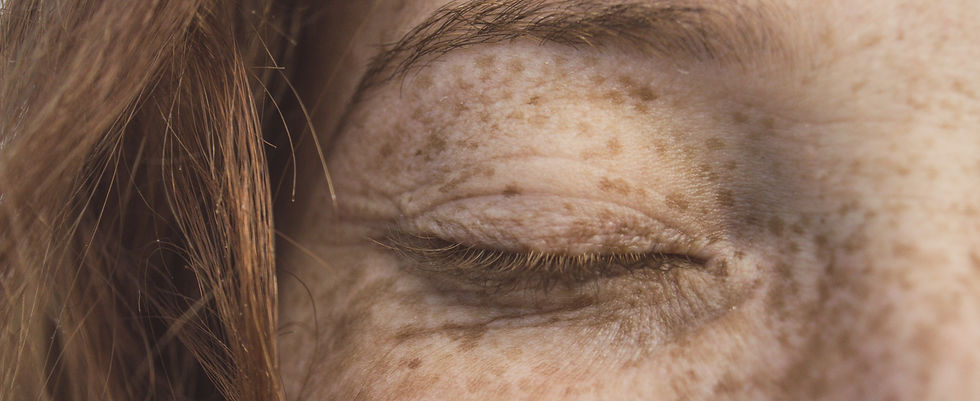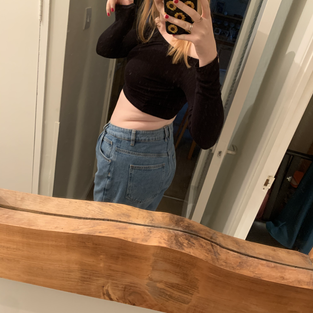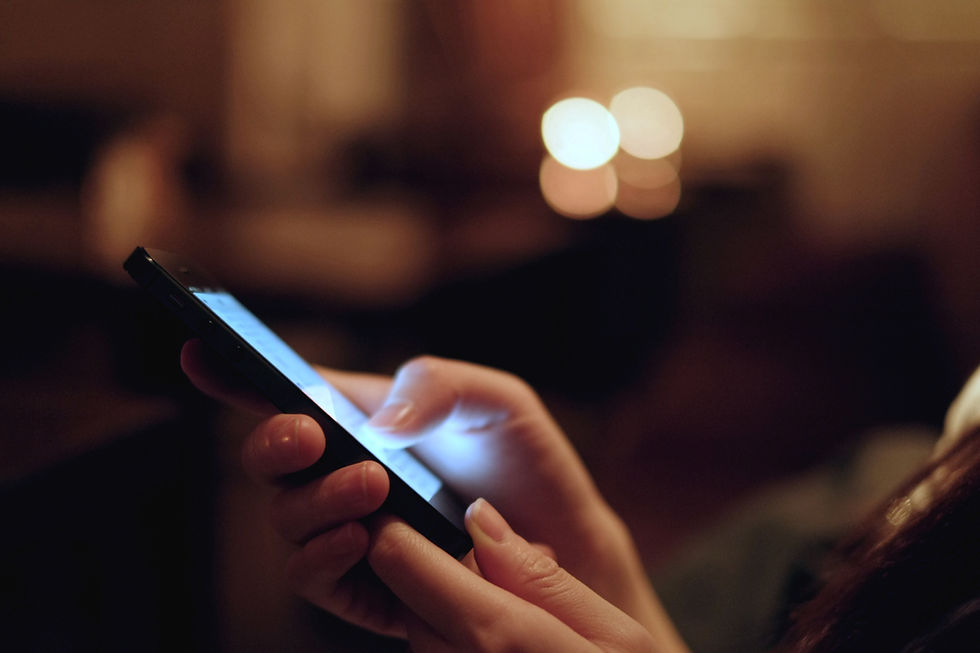Putting bodies into perspective 💭
- Fizz Barnardo

- Nov 25, 2020
- 8 min read

I don’t think we give our bodies enough credit. In a world where our society is telling us how to look ‘better’, lose weight and compare ourselves to Instagram models, it’s very easy to take it for granted and be resentful about the way we look.
I’m ashamed to admit that I am a full- time member of the ‘I hate my body’ club. For so long I’ve been convinced that my body shape is just completely wrong compared to everybody else. I don’t think I’m the only one, and I know it’s not just an issue that females face. I’m not going to lie – I’d love to be a size 8/10 again, have the confidence to wear a bikini, or believe I’m a realistic Victoria’s Secret model candidate, but I refuse to ignore the fact that my body works incredibly hard to protect me and keep me alive!
Being healthy means looking after your body; getting plenty of exercise and eating a balanced diet, but it also means looking after yourself psychologically. We could all do a lot more to become physically healthier, but we tend to neglect the need to have a positive mental attitude.
I’m not a doctor, psychologist or expert – I am just one of the many people who struggles to love my appearance and body. BUT, I wanted to share some things with you that will hopefully put your attitude towards your body into perspective, even if you don’t fall in love with it completely.

Body Neutrality
I came across this term a while ago and I think it’s a great place to start when trying to develop a better relationship with our bodies.
Body Neutrality is a philosophy that suggests we should be less concerned about the appearance of our bodies and instead focus on what they do for us. So for example, instead of thinking: “I hate my arms, they’re flabby and I have bingo wings” you say: “These are my arms, they help me to carry and reach things”. (Godwin, 2020 - Erynn Chambers).
It sounds like a pretty basic and practical way of thinking, but I think it’s a very interesting approach.
The concept of body neutrality was introduced by Anne Poirier in 2015 (Naftulin, 2020), who runs workshops in Vermont for those struggling with their weight or disordered eating. Neutrality is the idea that you have neither a strong love or hate towards your body, which contrasts to body positivity – the idea that you love and embrace your body whatever it looks like. Poirier suggests that it’s a pretty big ask for people to go from hating their bodies to totally loving them. Although the body positivity movement is amazing, it’s not that easy to jump from one extreme mindset to another. Neutrality is therefore an in-between – a stepping stone that helps lead to acceptance and regulates our emotions surrounding our bodies (Meltzer, 2017).

Putting your body into perspective
The way our bodies function is literally mind-blowing to me – why not get excited about what they do for us?! It’s very easy to judge our bodies on the outside, but a whole lot of stuff goes on under the surface to help us get through each day.
So, I’ve put together a few simple facts about how our bodies function based on a mixture of internet searching (all cited at the bottom bc plagiarism is NOT the one) and asking an expert GP (my Dad lol). Some of these aren’t revolutionary facts, but they are super important to think about. I’ve also broken these down into specific body parts in case there’s one aspect of your body that you’re reaaallllyyy not a fan of.
Skin

No matter whether it’s covered in acne, redness or scars, your skin does a LOT for you. Here are some reasons you can still appreciate it:
Your body’s largest organ is your skin. In fact, it’s so important that you have approximately 2 square metres of it (National Geographic, 2017).
It protects you from harm, detects infection and can heal itself! (That’s really smart!) (HSE, 2020)
It also helps regulate your temperature and produces vitamin D (HSE, n.d.), the vitamin that regulates your calcium and phosphate levels for healthy bones (NHS, 2020).
Shoulders
I definitely don’t love my broad shoulders, but they’re actually pretty cool if you think about it:
Your shoulders are designed to help you do a lot – rotate your arm, bend and reach almost anything. In fact, the structure of your shoulder and elbow enables you to place your hand anywhere within the radius of your arm length.
Also, we’re usually told to cover up our shoulders in professional contexts or at school. That must mean they’re something to brag about because they’re a little cheeky...
Chest

Whether you’re wanting defined pecs or bigger boobs, your chest contains some pretty important parts of you:
SO much goes on underneath your chest. It protects your vital organs including your heart and lungs, which work incredibly hard to keep you alive!
Ladies – your breasts can provide essential nutrients through the milk they produce. Your boobs can help keep a tiny human healthy and alive (that’s quite a big deal).
Stomach

I certainly find it hard to love my tummy – but there’s a lot that goes on under it, whether it’s totally flat or a little bit wobbly like mine:
Your gut is meant to have food in it – it’s main function is to literally store and digest food! In fact, if you stretched out the length of your large intestine, it would be around the width of a queen-sized bed! Ironically, your small intestine is even larger, measuring between 3 to 5 metres (Seladi- Schulman, 2019). So, don’t be too harsh on your stomach – it has a lot to fit in!
Your core muscles help you with everyday movements like sitting up, running, bending over and more, as well as aiding balance and stability. They also help you to transfer force between your lower and upper body (Mazzo, 2018).
Although not specifically your stomach, this is another one for the ladies. You have the potential ability to grow life in your womb (pretty sure this isn’t news to everyone). You can create, nurture, and grow a little human person inside your body which is literally amazing!
Arms

Whether they’re skinny or sporting bingo-wings, here are some reasons your arms are pretty cool:
Your arms have the ability to improve moods through the power of a simple hug! Hugs are actually thought to release a chemical called Oxytocin, which links to feelings of happiness and reduced stress (Cirino, 2018).
Your arms and hands contain a series of nerves which receive sensory information and allow them to move in even the most intricate ways. Your hand muscles alone contain around 200,000 neurons that help them to make super precise movements (Taylor, 2019).
Thighs

If you’re resentful of your thighs because they’re not muscular enough, or they’re the cause of some serious chafing in the summer, remember why your thighs are fabulous:
Your thighs contain your femur – which is the strongest and longest bone in your whole body, helping to support your skeleton and maintain posture (Doyle, 2011).
Your thighs also support all of your body weight when you’re standing upright – hence why they’re so strong (Healthline, 2018).
Legs

Too short, too long, too stumpy, too hairy… whatever your worry is, here’s why it doesn’t matter:
Your legs literally help you to stand, move, run and more! They even allow you to have a cheeky boogie occasionally, which has great benefits for your physical and mental health. Dancing has been found to positively impact mood and body image, as well as reduce feelings of depression and anxiety (Rath, 2018).
Feet

Anyone who knows me well knows that my feet are rank. But they still play an important role:
Your feet literally help you to stand upright, as well as allow you to walk, run, jump and more using their flexible structure (Hoffman, 2019)
Each foot has 26 bones, 30 joints and over 100 muscles to help provide balance, mobility, and support (Arthritis Foundation, n.d.).
Don’t forget…!
As Poirier suggests, the way we feel about our bodies is never going to change overnight – it’s a very gradual process. But if you’re still not convinced how fab your body is, here are some things that I find helpful to also bear in mind:
People have different body shapes

If there’s anything that Gok Wan has taught me, it’s that there are lots of different shapes out there – apples, pears, hourglass and loads more (I’d say I’m more of an ice lolly shape tbh).
If a friend and I wore exactly the same outfit, our body shapes would make them look very different, and it’s the same with weight. I could weigh exactly the same as somebody else, but our body shapes would distribute the same weight very differently – and that’s normal! So where possible, try not to directly compare your body to somebody else’s, because you have been uniquely created to look like you and nobody else!
Others know that you are beautiful – even if you don’t!

I think we tend to over analyse, when the reality is, not a lot of people will think twice about the aspects you stress about. You’d probably be surprised at the number of people who love your body and want a specific part of their body to look like yours. Saying that, those that love you don’t appreciate you because of your appearance, you are loved because you are a wonderful human with thousands of beautiful qualities. Your body shape and hang-ups aren’t something that outweigh your value as a person!
As always with my blogs, I am in no way an expert and I would LOVE to say that I always practise what I preach (but I don’t…). I know exactly what it feels like to be so obsessed and consumed with the way you look that it makes you feel genuinely sad and worthless. But in the same way that your worth doesn’t lie in your relationship status, job title or bank statement, it absolutely doesn’t come from the size or shape of your body either!
You don’t have to instantly fall in love with your body (I know I haven’t) – but learning to be thankful for the way it functions and what it does for you is one of the most refreshing and liberating feelings. Just remember that no matter what your body looks like or whether it has to work that little bit harder to get you through each day - it is constantly working behind the scenes to look after and protect you!
Stay wonderful and stay safe at such a crazy time!
Yours honestly,
Fizz xxx
References:
· Arthritis Foundation. (n.d.). Anatomy of the foot. Retrieved from: https://www.arthritis.org/health-wellness/about-arthritis/where-it-hurts/anatomy-of-the-foot#:~:text=Each%20foot%20is%20made%20up,main%20structures%20of%20the%20feet.
· Cirino, E. (2018). What are the benefits of hugging? Healthline. Retrieved from: https://www.healthline.com/health/hugging-benefits#4.-Hugs-can-make-you-happier
· Doyle, S (2011). Facts about bones in your skeleton. Retrieved from: https://www.hss.edu/playbook/facts-about-bones-in-your-skeleton/#:~:text=The%20femur%20bone%20is%20the,posture%20by%20supporting%20the%20skeleton.
· Godwin, C.M (2020). Body neutrality: What if you don’t really love or hate your body? BBC News. Retrieved from: https://www.bbc.co.uk/news/av/54003440
· Healthline. (2018). Thigh. Retrieved from: https://www.healthline.com/human-body-maps/thigh#1
· Hoffman, M. (2019). Picture of the feet. WebMD. Retrieved from: https://www.webmd.com/pain-management/picture-of-the-feet#1
· HSE. (n.d.). Structure and Functions of the skin. Retrieved from: https://www.hse.gov.uk/skin/professional/causes/structure.htm
· Mazzo, L. (2018). Why core strength is so important (It has nothing to do with sculpting a six-pack). Shape. Retrieved from: https://www.shape.com/fitness/tips/why-its-so-important-have-core-strength
· Meltzer, M. (2017). Forget Body Positivity: How About Body Neutrality? The Cut. Retrieved from: https://www.thecut.com/2017/03/forget-body-positivity-how-about-body-neutrality.html
· Naftulin, J. (2020). Body neutrality, not body positivity, may be the best way to fight unsustainable beauty ideals. Here’s how to channel it. Insider. Retrieved from: https://www.insider.com/what-is-body-neutrality-explainer-2020-8#:~:text=Body%20neutrality%20is%20a%20philosophy,has%20become%20a%20cultural%20buzzword.
· National Geographic (2017). Skin. Retrieved from: https://www.nationalgeographic.com/science/health-and-human-body/human-body/skin/#:~:text=Skin%20is%20our%20largest%20organ,than%20make%20us%20look%20presentable.
· NHS (2020). Vitamin D: Vitamins and minerals. Retrieved from: https://www.nhs.uk/conditions/vitamins-and-minerals/vitamin-d/#:~:text=Vitamin%20D%20helps%20regulate%20the,condition%20called%20osteomalacia%20in%20adults.
· Rath, L (2018). Move: The health benefits of dancing. Bupa. Retrieved from: https://www.bupa.co.uk/newsroom/ourviews/health-benefits-dancing
· Seladi-Schulman, J. (2019). What’s the length of your small and large intestines? Healthline. Retrieved from: https://www.healthline.com/health/digestive-health/how-long-are-your-intestines
· Taylor, T. (2019). Nerves of the Arm and Hand. Retired from: https://www.innerbody.com/anatomy/nervous/arm-hand
Images:
Deon Black from Pexels Andrew Wilus from Pexels
Daria Sannikova from Pexels
Anna Shvets from Pexels Chermiti Mohamed from Pexels
Anna Shvets from Pexels (All others images taken from Wix.com)










Comments